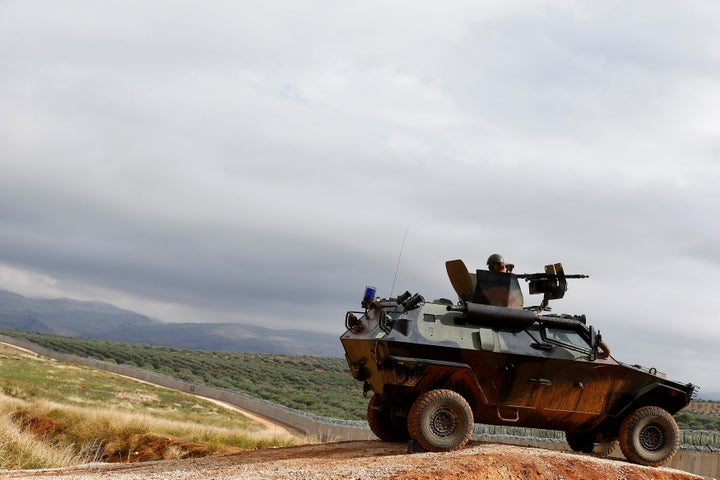President Donald Trump’s rally in Florida on Saturday night drew significant media attention as he took aim at the press, railed against immigration and made a confusing statement about Sweden that he was later forced to clarify.
But somewhat lost in the coverage of Trump’s speech was his assertion, once again, that the U.S. plans to build safe zones in Syria, and that other countries will pick up the tab.
“We’re going to have the Gulf States pay for those safe zones,” Trump told supporters. “They have nothing but money.”
Trump’s argument is that safe zones in Syria would help reduce the flood of refugees coming from that country. But there are a number of questions about how such a plan would be negotiated and implemented. Even if the U.S. were to somehow convince Gulf States to cover the huge costs of a safe zone, there is the more important issue of how the zones would be enforced.
Declaring a safe zone, unlike building a border wall, does not create a physical deterrent that guards a certain area of land. Safe zones necessitate a huge military presence in order to provide protection for civilians, and there can be catastrophic consequences if those forces are unable to keep the area safe.

A safe zone in northern Iraq that was briefly implemented in 1991 required 20,000 troops from a number of nations to protect. Analysts consider this safe zone a relatively successful case, but it involved a major military operation and tremendous resources, and it lasted only a few months. Syria’s conflict, meanwhile, looks unlikely to end anytime soon, and presents a far more complex situation than the Iraqi case.
Any plan to implement safe zones in Syria and possibly neighboring countries would need to address threats from the Syrian regime, Russian air forces and a multitude of non-state armed groups involved in the conflict. Syrian President Bashar Assad rejected the idea of safe zones in an interview with Yahoo News earlier this month, saying that “it’s not a realistic idea at all.”
“You would need some forces on the ground, as well as air power.”
- Professor Daniel Byman, School of Foreign Service, Georgetown University
If the U.S. doesn’t have the cooperation of the Assad government, experts say setting up safe zones in Syria with the aim of protecting internally displaced persons would be seen as a hostile act ― tantamount to carving out a piece of territory.
“We can think it’s purely humanitarian, but it’s not going to be perceived as such,” said Daniel Byman, a professor at Georgetown University’s School of Foreign Service. “You would need some forces on the ground, as well as air power.”
Operating a safe zone would require defending the borders of the territory and policing the people within, particularly against infiltration from Islamic State militants and other armed groups. It could take tens of thousands of troops to properly secure such an area, analysts say.
And safe zones can become hugely vulnerable targets if the forces meant to protect them fail to do so. In the Bosnian civil war, the United Nations-designated safe area of Srebrenica became the site of a massacre after Bosnian Serb troops overran the lightly defended town. The forces killed 8,000 Bosnian Muslims, committed rape and sexual abuse and forced tens of thousands to flee.

Even if the safe zones were properly protected, analysts say the commitment to enforcing the zones would bring about the potential for increased U.S. intervention in Syria’s war and the dangers associated with that. One of the reasons former President Barack Obama was reluctant to pursue Syrian safe zones was the fear of such an escalation.
“There was a concern in the Obama administration that this could lead to a slippery slope,” said Melissa Dalton, a Pentagon official during the Obama administration and current senior fellow at the Center for Strategic and International Studies. “Did the U.S. really want to embroil itself in another protracted conflict that could expose U.S. forces and interests to great risk?”
Despite the various challenges that safe zones present, they’ve been floated as an option in Syria almost since the start of the country’s conflict in 2011.
Former Secretary of State Hillary Clinton and Republican Sens. John McCain (Ariz.) and Marco Rubio (Fla.) have previously called for implementing safe zones in Syria. German Chancellor Angela Merkel and Turkish President Recep Tayyip Erdogan have also promoted the idea as a means of managing the exodus of refugees out of Syria.
Trump advocated for safe zones during his presidential campaign, and an early draft of his executive order on immigration that circulated in the days after his inauguration contained a provision calling for “safe zones to protect vulnerable Syrian populations.” That part was left out of the final version of the executive order, for unknown reasons.
Some analysts argue that politicians support the idea of safe zones because they see them as a way to help suffering people without actually getting into a war. But the reality tends to be more complicated than that.
“This sounds good to most ears because it sounds like a halfway measure, but to me it’s actually more risky than both the alternatives, because you’re still not solving the problems in any way but you bring on a lot of costs and risk,” Byman said.
As for Trump’s promise that Gulf States would somehow pay for these safe zones, Byman was skeptical: “That’s not gonna happen.”
